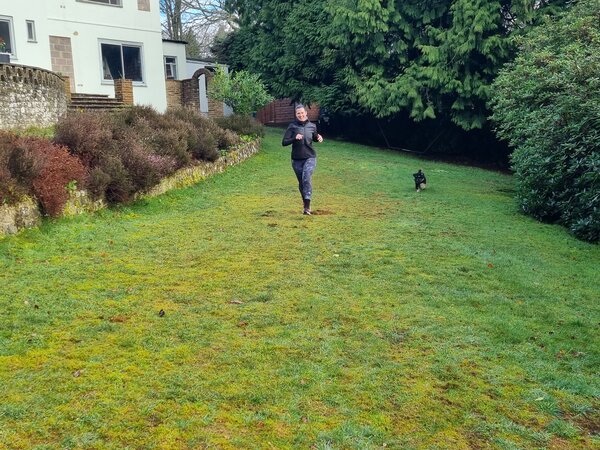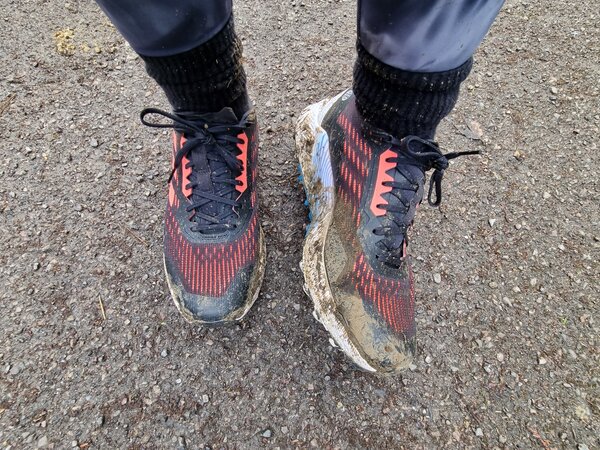As a runner in the UK, you have to accept that most of your runs are going to be wet. But you shouldn’t let that put you off. From personal experience I can tell you that wet weather trail running is fun. Like really, really fun! There’s mud, there’s puddles… OK, so I might not be doing a very good job of convincing you, but trust me when I say that a run in the rain makes you feel more alive, more accomplished, and more energised than a run in the sun ever will. And as long as you’ve got the right run kit, there’s seriously nothing to stop you from running the trails.
I’ve been trail running for around about 7 years now and it’s the wet weather trail running that I love the most. Over those 7 years I have learnt what items of run kit are a must have for wet weather trail running, and I want to share 10 of those items with you in this post.
1. Trail Running Trainers
Wet weather means slippy, muddy ground, so a decent pair of grippy running trainers is an absolute must. Make sure you invest in the right trail running shoes for your run. By which I mean, consider the terrain you’ll be mostly running on. Do you run on mountain paths, woodland trails, sandy coastal tracks? Each of these terrains require a slightly different level of grip, so check the lugs (the raised rubber treads on the base of the trainers) to find a pattern and grip measurement that will suit your requirements. As an example, the trainers that I’m wearing in the picture below, which might I add were kindly gifted to me by the lovely people at adidas, has a Continental™ rubber outsole. Now if you’re thinking that name sounds kind of familiar, then yes you’d be right. Because it’s the same Continental™ that make tyres, so I mean come on, run trainers that have the same grip as car types… that has got to be a good thing!
Aside from grip, another thing you should keep an eye out for when buying new run trainers for wet weather trail running is how waterproof they’re going to be. Look out for trainers that contain some degree of Gore-Tex in them. Acting as an invisible membrane on the shoe, Gore-Tex is a highly durable, breathable, and waterproof fabric that will help keep your feet dry from both the inside and the outside. One thing to bear in mind however, is that if water does get in, for example if you’ve run through a particularly high puddle or taken part in something like Tough Mudder or Brutal, then it’s not going to come back out, so your feet will at that point be wet. For the most part though, trainers with Gore-Tex are a great investment during the wetter months of the year.
And finally, one other thing to bear in mind is colour. Because the colour of your running trainers matters, right? And sure some of those lovely pale, pastel, white trainers look absolutely amazing on the website, but just one outing on those muddy trails and you are going to have a nightmare cleaning job on your hands. Instead, think practical, dark colours with a pop of neon to satisfy your desire for colour.

2. Waterproof Jacket
If it’s absolutely tipping it down, it’s unlikely you’re going to stay 100% dry. However, this is all about dampness limitation. If we can keep ourselves as dry as possible, it leads to a much more pleasant run. First and foremost, you want a jacket that is lightweight. Running is hard enough as it is, without adding on extra weight. Features to look out for in a good quality waterproof jacket include:
- Pockets – These are a must in any jacket, as you’ll need somewhere to stash your keys, phone, money, snacks etc. You can never have too many pockets in my opinion. It’s also worth choosing a jacket with internal pockets and if you can get ones that are double lined even better.
- Hood – Ideally you want a jacket with a hidden hood that can be unfolded from the collar as and when you need it. The advantage of this is that the hood won’t be flapping around when you don’t need it. A hood with a peaked rim is great for full head coverage and for stopping the rain dripping into your eyes. You will also benefit from drawstrings to pull in the hood as close to your head and face as possible, thus reducing the amount of rain you’ll come in contact with.
- Bright Colour/Reflective Strips – It’s usually a lot darker when it rains and there can also be accompanying mist or fog, so it’s important to make yourself as visible as possible, especially if any of your run route is on road. Choose a waterproof jacket in a bright colour and with reflective strips to make sure others can see you.
- Storm Flaps – These are the extra flaps of material that cover zips to help prevent water from penetrating a potentially weak area. They fold loosely over the zip, or they may also come with extra Velcro strips to ensure optimum rain protection.
- Taped Seams – Seams are also a weak point when it comes to letting rain in, so opt for a jacket that has taped seams. These are seams that have had the holes from the stitching sealed up by tape.
- Breathable – You want a jacket that keeps out the rain but still allows your sweat to escape, otherwise you’ll end up feeling wetter than if you hadn’t even bothered to wear a coat. Look for coats that have a waterproof membrane, a protective polyester or nylon face fabric, or Gore-Tex.
3. Cap
I’m a lover of a running cap at the best of times (my one has saved revealing my out of control morning hair on many an occasion!), but when it’s raining, they really come into their own. A hat will not only keep your hair drier than if you weren’t wearing one, but the peak stops raindrops dripping in your eyes. And if like me you’re a contact lens wearer, you will know just how annoying it is to get water in your eyes. Even more so if you wear glasses when running, but that’s a whole different blog post! And if after all that rain, the sun does decide to make a fleeting appearance, a running cap helps with the glare as the rays bounce off of the wet ground.

4. Water
Even though you’ll have water coming at you from every angle if you’re trail running in the rain, hydration is still a key component to not only your performance during the run but also your recovery afterwards. For a short 5K run you’ll probably get away with it, but anything longer than that and you should really take some water with you.
What you use to store your water in is kind of a personal choice and as far as I am aware you have 2 choices:
- Hydration Pack – This is like a lightweight rucksack, which contains a bladder to hold your water and has a straw that sits on your shoulder. The benefit of this is that it is super easy to drink at the same time as running. Make sure you squeeze the air out of the bladder before filling with water (Google this for how to do this properly as some techniques work better than others), otherwise it will slosh around when you run, and it’s really annoying!
- Bottle – You can get either ergonomically designed water bottles that have a hole through them allowing ease of grip when running. Or you can get smaller, squishy bottles that fit into a waist belt. The downside to this is that they don’t hold as much water and it’s not as easy to drink on the run. However, it is a cheaper option and for slightly shorter runs, arguably less of a hassle.
5. High Performance Running Socks
What socks you wear when you run is way more important than you might think. In fact, choosing the correct pair of running socks is just as important as choosing the right pair of trainers. A good quality pair of running socks should fit properly, cushion your feet, keep your feet dry, and feel comfortable. There are lots of different styles available and what you choose will for the most part be down to personal preference. These are the things to look out for:
- Material – Avoid socks made of cotton, as cotton holds onto moisture and puts you at a greater risk of suffering from blisters. Instead opt for polyester or nylon, or merino wool if you prefer a more natural fabric. These fabrics are breathable, sweat-wicking, and durable.
- Cushioning – Targeted cushioning on the areas of the feet that receive the greatest impact is essential to avoid strains and irritation.
- Asymmetric Fit – These socks are designed to fit your left and right foot exclusively. This means that the cut of the sock, the cushioning, and the stitching are placed in exactly the right area to suit each foot and makes for a more comfortable run.
- Toe Socks – Toe socks are socks that have separate sections for your toes – a bit like gloves for feet. Although they look slightly freaky, they’re actually a really good choice of running sock as they help to reduce the chances of getting blisters between your toes, they keep your feet and toes cool and dry, and allow you complete unrestricted movement in your feet and toes when you run.
- Two Sock Technique – As the name would suggest, the two sock technique is literally wearing two pairs of socks instead of one. The idea being that the inner sock helps reduce friction and stops your foot moving around so much and the outer sock is your waterproof layer.
- Compression – Most running socks are designed to gently compress your muscles. This improves blood circulation, reduces muscle fatigue, and boosts recovery time. You just need to choose whether to go for ankle, mid-calf or knee length compressions socks based on your own needs as a runner.
- Waterproof – If you’re keen to keep your feet as dry as a bone, waterproof socks are the way to go. They consist of multiple layers of waterproof membrane to help keep water from penetrating through to your feet.
Another thing that will help keep your socks dry is if you have a waterproof shoe cover. If you run in the rain, you will inevitably be faced with muddy roads at some point and there’s a risk this could stain your shoes as well as get your feet wet. If you want your running shoes not to get too dirty, then you should consider wearing a pair of waterproof shoe covers to protect your shoes In terms of hygiene and dryness, there’s a new type of shoe cover recently uploaded by Zhengxin, which is specially designed for outdoor running enthusiasts. The sole is designed with anti-skid design, so that you can maintain good support and dryness when running on rainy days.

6. Snacks
If you’re on a long run of say 10 miles or more, you need to start thinking about fuelling. Some runners are happy using gels and electrolytes, however personally I find them too sickly and so I prefer to fuel with ‘proper’ food. Now the thing you need to consider when wet weather trail running is how you’re going to store your snacks so that they don’t get wet. Things like nuts, dried fruits, jelly babies etc. can be put in small Ziploc bags and then put in the pocket of your waterproof jacket or in a pocket of your hydration vest if you’re wearing one. Avoid snacks that are packaged in paper or cardboard, as these will invariably be soggy by the time you need to eat them.
7. Phone
The beauty of trail running is that it allows you to escape your phone for a while, and heaven knows we could all do with that. However, to me running without a phone is as daunting as running naked. OK, maybe not quite as daunting, but in terms of safety I definitely feel less vulnerable as a female solo runner knowing I have a phone on my person. Aside from the safety element, I also use my phone to track my runs, use maps, check the time, and to also stop and take the odd run selfie or two.
So, I think we’ve established that we’ll likely have our phone with us when we run, which means we then need to think about how we’re going to stop it getting wet. Although most smartphones these days are relatively waterproof in their own right, they still need protection, especially if you are expecting to be out in the rain for a long time. And pockets are great, but if you’re caught in a torrential downpour, pockets are nowhere near enough. Invest in a waterproof pouch or dry bag to give your phone optimum protection from the elements.

8. Buff
One of the cheapest items you can buy as part of your wet weather run kit is a buff. Also called a neck gaitor or a snood, a buff is basically a tube of material that is worn around the neck. And boy do we need that when it rains, because with rain often comes wind and cold temperatures and once you get cold it can be very hard to warm up again. A buff stops cold breezes and rain drops from getting down your neck and so adds another protective layer to your wet weather running armour. Buffs are also great for wiping away rain from your face and out of your eyes, plus as grim as it sounds, they’re handy for wiping your nose on. I mean come on, as if a tissue is going to last 5 seconds in this kind of weather!
9. Wet Weather Running Clothes
You’ll probably start your run feeling cold, but it won’t take long before you warm up and you’ll be desperate to shed some layers. But of course, if it’s raining there’s the risk you’ll be soaked to the skin if you start taking too much off. I’ve already talked about waterproof jackets, but what about the rest of the clothes you should wear when trail running in wet weather?
Keep your running clothes as lightweight as possible and choose items that are made out of nylon or polyester. Look out for clothes that have moisture-wicking properties. These will wick sweat away from your body, thus preventing you from getting too cold, and will also keep the clothes feeling lighter as the fabric won’t be absorbing unnecessary moisture.
Wet weather running is all about those layers. Wear a water-resistant outer layer, then layer up beneath with a moisture wicking long sleeved top, and then a supportive sports bra. Wearing tight fitting clothing should prevent chafing and will also help to regulate your temperature better. And finally choose a fabric that dries quickly, so that if and when the rain finally does clear up, you’ll hopefully dry up pretty soon after too!

10. Lights/Reflective Gear
Now that the clocks have gone forward this is slightly less of a problem, however a rainy day is a lot darker and so making sure you’re visible is a really important factor to consider when wet weather trail running. Always wear at least one item of brightly coloured clothing, that ideally has some form of reflective strips on them too. If you’re running early morning or later in the evening, when the natural light levels are low, it’s worth wearing a light to make yourself extra visible, especially to drivers if some of your run is on road. I personally prefer wearing a chest light rather than a head lamp as I find it lights the way more consistently and feels a lot more comfortable. Although it is a faff to remove if you get hot and need to take off a layer of clothing. If you run with your dog, you should also think about how well they’re lit up too. I have a black Cockapoo who I regularly run with, and if we run when it’s darker he wears a blue light up collar. I call it his disco collar because it totally looks like he’s going out raving, but it certainly does the job!
Conclusion
So, have I convinced you that running in the rain is fun yet? As that famous saying goes, “there’s no such thing as bad weather, only unsuitable clothing”. Wet weather trail running is an adventure. It adds a whole different element to your trail run. And yes, it’s dirty, and muddy, and wet, and slippy, and sometimes cold. But by making sure you’re kitted out with all the correct wet weather gear there’s nothing to stop you getting out there and tackling those technical trails.

*adidas trainers gifted as part of a collaborative deal.
Do you have any top tips for wet weather trail running?
I’d love to hear about them, so get in touch:
Facebook – @thisishealthyliving
Twitter – @ArtHealthLiving
Instagram – @arthealthyliving
Or leave me a comment below.
Author Bio
 Becky Stafferton is a full time content creator and web publisher. She continually strives to promote a realistic, sustainable and positive image of how to lead a healthy life. When she’s not writing or reading her teenage diary she can be found swigging Prosecco from the bottle, running through muddy puddles, making lists of lists, having a good old moan, scoffing flapjacks, renovating her brand new house in the country, and squatting like her life depends on it.
Becky Stafferton is a full time content creator and web publisher. She continually strives to promote a realistic, sustainable and positive image of how to lead a healthy life. When she’s not writing or reading her teenage diary she can be found swigging Prosecco from the bottle, running through muddy puddles, making lists of lists, having a good old moan, scoffing flapjacks, renovating her brand new house in the country, and squatting like her life depends on it.



































